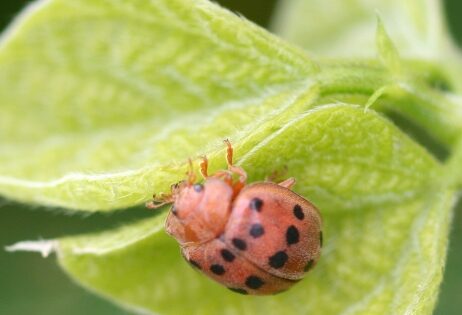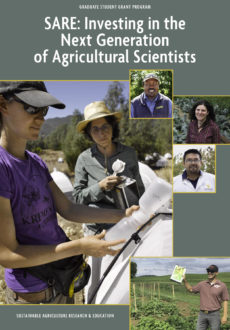Controlling Sheep Parasites with Alternative Dewormer Treatments
Javier Garza, Louisiana State University
Overuse of dewormers to control internal parasites in sheep has made certain parasites resistant and almost impossible to manage. This poses a serious threat to profitability for farmers, and has caused many researchers to focus on finding alternative treatments.

At Louisiana State University (LSU), Javier Garza used a 2009 SARE Graduate Student grant to research alternative treatments for the gastrointestinal nematode parasite Haemonchus contortus. This parasite is a blood feeder that impacts profitable small ruminant production in the Southeastern United States and worldwide. “The problem has become so severe that it is threatening viability of small-scale and limited-resource small ruminant farm operations despite continued high demand for sheep and goat products,” Garza says.
Garza’s research teamed him up with LSU professor James Miller, who has made good use of the SARE Graduate Student grant program in his work to evaluate and promote alternative, non-chemical methods for controlling parasites in small ruminants.
Miller has served as advisor on four Graduate Student grant projects, a program he views as important for generating data to support hypotheses about alternative strategies. Plus, “we’ve found no bad results yet,” he claims.

Garza’s project compared the efficacy of two cost-effective treatments of H. contortus infection: copper oxide wire particles and copper sulfate. He found that copper oxide wire particles was the more efficacious treatment. Some producers, knowing of copper sulfate’s low cost and possible effectiveness, were putting it in feed every day to keep copper levels up. This practice concerned Miller and Garza because it can cause toxicity through the accumulation of copper in the liver, which destroys blood cells. So, their project focused on administering these copper-based treatments as a drench, not through feed. They found that administering copper oxide wire particles two times at five-week intervals provided effective control and caused no liver toxicity.
As a result of their work, numerous sheep producers have inquired about using copper oxide wire particles for controlling H. contortus infections. Their feedback has been positive and encouraging, say both Miller and Garza.
As of 2016, Garza continued his research on the parasite as a Ph.D. candidate at West Virginia University. He remained focused on alternative control methods by studying host-parasite reactions and natural immune responses. Miller stresses the importance of the four graduate student projects in providing sheep producers with an integrated set of alternatives, rather than attempting to identify a single solution. “Producers want the best treatment, but there isn’t a best treatment,” Miller says.
For more information, go to www. sare.org/project-reports and search for the graduate projects Miller has coordinated: GS05-047, GS07-059, GS08-071 and GS09-083.
Effect of a condensed tannin containing forage (sericea lespedeza), fed as pellets, on natural and experimental challenge nematode infection in lambs (GS05-047)
Dr. James Miller, Louisiana State University - $10,000
Effect of a grazing sericea lespedeza as a treatment padock for controlling natural nematode infection in lambs (GS07-059)
Dr. James Miller, Louisiana State University - $10,000
Effect of sericea lespedeza leaf meal pellet supplementation on Haemonchus contortus infection in grazing ewes (GS08-071)
Dr. James Miller, Louisiana State University - $10,000
Effect of copper oxide wire particles compared to copper sulphate on Haemonchus contortus infection in lambs (GS09-083)
Dr. James Miller, Louisiana State University - $10,000
Identifying Alternative Practices for Controlling a Snap Bean Pest
Louis Nottingham, Virginia Tech
After receiving an undergraduate education in biology and working in fish and wildlife management, Louis Nottingham developed an interest in sustainable agriculture, appreciating its “real-world” applications, especially in horticulture and field crops. While searching for a graduate program, he ran into entomology professor Thomas Kuhar at a Virginia Tech research field, where the two discussed the importance of sustainable pest management. A short two months later, Nottingham moved to Virginia to work with Kuhar.

In the course of his studies, Nottingham received a 2013 SARE Graduate Student grant to research cul-tural strategies for controlling Mexican bean beetles in snap beans, grown on over 5,500 acres in Virginia and considered an important crop in the state.
Kuhar, who has served as faculty advisor on three other SARE Graduate Student grant projects and is a fan of the program, was Nottingham’s advisor.
Kuhar appreciates the program be-cause it teaches students grant writing and project management. The program encourages students, he says, to include additional research objectives to an ongoing project, especially ones that take a closer look at sustainability and help farmers with the challenges they face. It “clearly gets the students thinking about the research that they are doing and how it fits in the real world,” Kuhar says.
This held true with Nottingham. His graduate research focused on cultural control strategies that could reduce the need for chemical foliar applications on snap beans. Originally he was not looking at mulch as a possible strategy, but was able to add it as a research objective when he got the SARE grant. Mulch wound up being the best alternative he found. “The grant allowed me to expand my research and dive deeper into some of the questions I had,” Nottingham says.
The program …‘clearly gets the students thinking about the research that they are doing and how it fits in the real world.’
The project found that reflective or metalized plastic mulches significantly reduce populations of Mexican bean beetles, a serious pest of snap beans, while increasing yields. The mulch produced significantly greater pod yields than all the other treatments—more than double that of bare soil plots.

Although metalized plastic mulch costs roughly $45 for 200 feet and black plastic costs about $30 for 200 feet, mulch is cost effective because growers can more than double their yield compared to bare soil, according to Kuhar.
True to the Graduate Student grant program’s purpose, Nottingham rec-ognizes the real-world benefit of his research. “Because our plastic mulch study is very applied and produced clear results, I encourage growers to try plant-ing beans on metalized mulch, especially if they encounter large populations of Mexican bean beetle,” he says.
In his Ph.D. program, Nottingham is pursuing some of the other strategies he evaluated, using the preliminary data he collected during his SARE project.
Trap cropping for management of Harlequin bug in cole crops (GS09-081)
Dr. Thomas Kuhar, Virginia Tech - $9,523
Management of Mexican Bean Beetle, Epilachna varivestis Mulsant, in Snap Beans Using Cultural Control Strategies (GS13-120)
Dr. Thomas Kuhar, Virginia Tech - $10,622
Making Pest Management More Sustainable in Cucurbit Production (GS14-131)
Dr. Thomas Kuhar, Virginia Tech - $10,922
Improved Trapping Strategies for Managing Harlequin Bug: Applying recent research and discovery of its aggregation pheromone as a tool for vegetable growers (GS15-144)
Dr. Thomas Kuhar, Virginia Tech - $9,893
